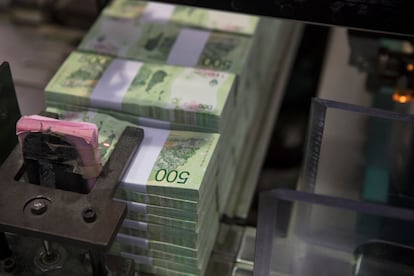Argentina halts banknote printing as Milei turns to Chinese suppliers
The government has also decided to intervene in the national mint for 180 days, citing serious infrastructure deficiencies, obsolete machinery, and a debt of nearly $400 million


Amid Javier Milei’s ongoing efforts to dismantle the state, attention has turned to the Casa de Moneda, the entity that has been responsible for printing banknotes and minting legal tender coins in Argentina since 1875. The executive has decided to intervene in this state-owned company, which employs nearly 1,300 workers, and has suspended the printing of banknotes. In fact, the supply of banknotes now primarily comes from abroad, particularly from China. “The government continues to attack our economic sovereignty,” denounced the state workers’ union ATE.
Earlier this month, the Milei administration announced a restructuring of the Casa de Moneda. On Monday, the Central Bank of the Republic (BCRA) terminated its contracts with the company, citing high costs, non-compliance, and delays in the provision of 1,000 and 2,000 peso bills — values that have been eroded by inflation (which currently equate to approximately $1 and $2, respectively). In Argentina, a country of 46 million inhabitants, it is estimated that nearly 12 billion bills are in circulation, many of which are losing value and becoming increasingly obsolete, leading to significant storage issues.
“All production processes related to the manufacture of banknotes will be halted. For this reason, all personnel exclusively assigned to this production activity will be allowed to use any available vacation periods,” was the message received by workers following the BCRA’s decision.
Manuel Adorni, the spokesperson for the Presidency of Argentina, said that the executive’s goal is to “make the mint more efficient.” He added: “We believe that issuing low-denomination bills does not make sense in terms of cost-benefit.” The Milei government also decided to intervene in the company for 180 days, citing serious infrastructure deficiencies, obsolete machinery, and a debt of nearly $400 million.
The State Workers Association (ATE), through its internal board at the Casa de Moneda, criticized Milei’s government for bringing the company to “a point of no return.” The ATE argued: “The fundamental tools of an independent economy are threatened with extinction by an ideology that prefers to import banknotes from elsewhere rather than defend its own industry and sovereignty.” The Federación Gráfica Bonaerense union also accused the government a month ago of trying to dismantle the Casa de Moneda and exclude it from the BCRA tenders for banknote printing.
The supply of higher denomination banknotes, specifically the 10,000 and 20,000 peso notes implemented by the current administration, has been entrusted to foreign suppliers. Under the previous government led by Alberto Fernández, paper money began to be imported from Brazil, Spain, France, China, and Malta in response to a demand for banknotes driven by inflation that reached nearly 300% year-on-year.
When Milei took office last December, the new authorities opted to prioritize imports, citing concerns over costs and production times. Consequently, the Chinese state-owned company Banknote Printing and Minting Corporation (CBPMC) has become the primary supplier, already sending batches of banknotes and committing to additional orders. The U.S. firm Crane Currency also secured a tender.
For the time being, according to the government, the mint will continue to produce passports, stamps, license plates, and vehicle documents. Although the government has decided to dissolve the private printing company South American Securities Company, whose assets are administered by the mint, the future of the Casa de Moneda remains uncertain. The executive must determine whether to move toward its definitive closure, attempt to privatize it, or retain it within the state apparatus, albeit in a significantly reduced capacity compared to its former role.
Sign up for our weekly newsletter to get more English-language news coverage from EL PAÍS USA Edition
Tu suscripción se está usando en otro dispositivo
¿Quieres añadir otro usuario a tu suscripción?
Si continúas leyendo en este dispositivo, no se podrá leer en el otro.
FlechaTu suscripción se está usando en otro dispositivo y solo puedes acceder a EL PAÍS desde un dispositivo a la vez.
Si quieres compartir tu cuenta, cambia tu suscripción a la modalidad Premium, así podrás añadir otro usuario. Cada uno accederá con su propia cuenta de email, lo que os permitirá personalizar vuestra experiencia en EL PAÍS.
¿Tienes una suscripción de empresa? Accede aquí para contratar más cuentas.
En el caso de no saber quién está usando tu cuenta, te recomendamos cambiar tu contraseña aquí.
Si decides continuar compartiendo tu cuenta, este mensaje se mostrará en tu dispositivo y en el de la otra persona que está usando tu cuenta de forma indefinida, afectando a tu experiencia de lectura. Puedes consultar aquí los términos y condiciones de la suscripción digital.










































